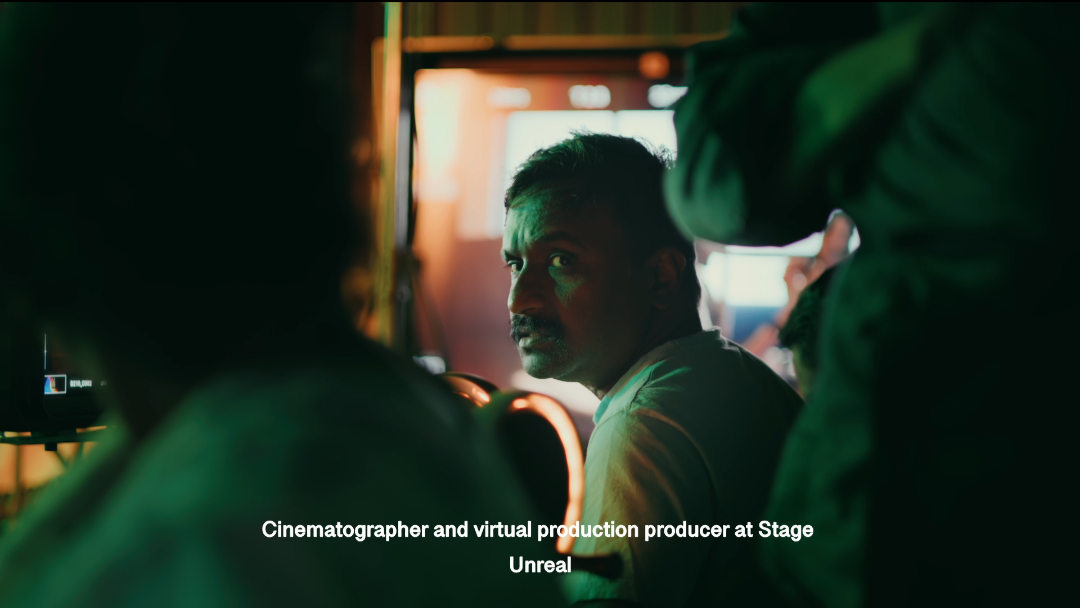
Manoj Paramahamsa: Cyber Gaffer/ Virtual!
Aug 08 2025
🎥 Manoj Paramahamsa ISC – Introducing Cyber Gaffing to Indian Cinema

Popular cinematographer Manoj Paramahamsa is known for pushing the boundaries of technology in storytelling.
Now, through his Stage Unreal team, he is introducing Indian cinema to a revolutionary but still little-known craft — Cyber Gaffing.
✨ While Manoj has successfully implemented Virtual Environments in high-profile films like Radhe Shyam and Leo, cyber gaffing is still under the radar in the Indian film industry. Few have seen it in action, and even fewer understand how it works. But as virtual production grows, cyber gaffing is set to become a vital part of filmmaking.


💡 What is Cyber Gaffing?
Cyber Gaffing is the hybrid art of lighting — combining:
1️⃣ Physical Lighting – 🎛️ Real lights, fixtures, and tools to illuminate actors and set pieces.
2️⃣ Virtual Lighting – 🌐 Controlling light sources in real-time 3D environments like Unreal Engine, used in LED volume walls or compositing.
🔗 The cyber gaffer’s job is to merge these two worlds seamlessly, so the audience cannot tell where reality ends and the virtual world begins.



🛠 How Cyber Gaffing Works – Manoj’s Approach
1. 🗺 Planning the Light in Two Worlds
📍 Pre-production with the Virtual Art Department (VAD) to identify key light sources — both real & virtual.
2. 💻 Setting Up Virtual Lights
Inside Unreal Engine, adjust brightness, color, shadow softness, haze, or fog for digital lights.
3. 🎬 Setting Up Physical Lights
On set, place real lights matching the direction, color temperature, and shadow style of virtual ones.
4. 🔄 Synchronizing Physical & Virtual
Using DMX control linked to Unreal Engine, both light types move in perfect sync.
Example: A virtual sunset lowers → the real key light also lowers & warms automatically.
5. ⚡ Live Adjustments on Set
“Make it golden hour 🌅,” “Dim the streetlamps 💡,” or “Add moonlight glow 🌙” — done instantly without lengthy resets.
🚧 Why It’s Not Mainstream Yet
- 🧠 Specialized Skillset – Needs mastery of traditional lighting + technical know-how of game engines & DMX.
- 🏗 Infrastructure – Best with LED volume stages or high-end previsualization pipelines.
- 💰 High Initial Cost – Expensive setup for equipment & workflow.
- 📢 Awareness Gap – Many Indian filmmakers are still learning what’s possible


🎓 Training the Next Generation
To bridge the gap, Manoj Paramahamsa has partnered with Cinema Factory Academy, Chennai, to train students in cyber gaffing and virtual production — preparing them for the future of filmmaking.
🔮 The Future
As virtual production expands in India, cyber gaffing will go from an industry secret to a mainstream skill.
In a few years, the Cyber Gaffer may be as essential as today’s traditional gaffer — and thanks to pioneers like Manoj Paramahamsa, Indian cinema will be ready.
Cyber Gaffing – A New-Age Lighting Revolution
Cyber gaffing has emerged as a highly productive tool for film, music video, and advertisement productions. In the advertising world, a shoot often lasts only a single day, yet it involves weeks of preparation — from concept art to set design and ultimately the lighting stage. Similarly, music videos demand the creation of multiple setups and scenarios within a single day’s shoot.
Cyber gaffing makes these challenges far more manageable by enabling precise, seamless, and repeatable lighting setups in virtual previsualization before stepping onto the set. This means that creative and technical decisions — from the mood and colour palette to the intensity and direction of light — can be locked in early, saving valuable on-set time.
Latency Company has brought cyber gaffing into play by combining the mental maths of light with the physics of light, integrating this knowledge into the Unreal Engine. It is essentially a sophisticated extension of DMX lighting control, offering greater calibration in direction, colour, and intensity, along with advanced virtual pre-lighting capabilities.
Manoj explains that, from the user’s perspective, this technology will be a game-changer for feature films as well. It opens up new creative possibilities, reduces trial-and-error on set, and can save days — even weeks — of production time. For high-pressure shoots where precision and speed are critical, cyber gaffing is poised to become an essential part of the workflow.
In short:
Manoj isn’t just using cyber gaffing — he’s introducing it to Indian cinema, building the bridge between real & virtual worlds, and training the next generation to light the films of tomorrow. 🌟🎬
Drafted by
CJ Rajkumar
Author/ Cinematographer
